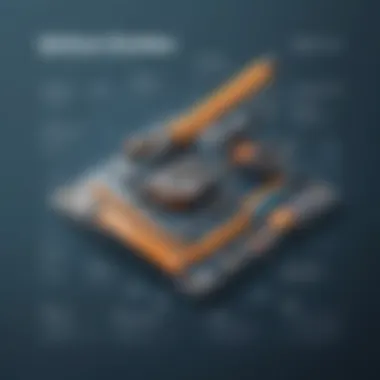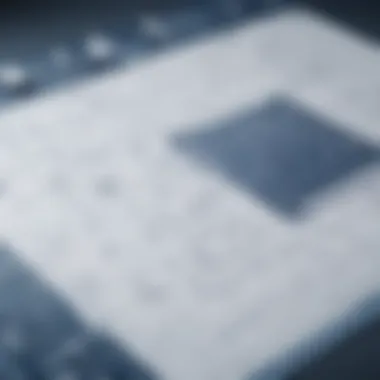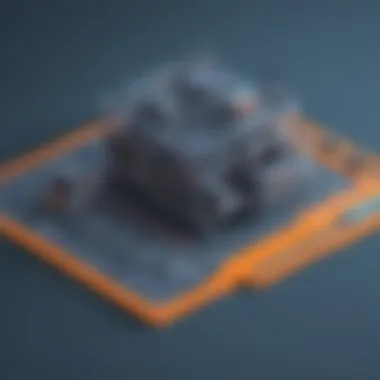Crafting Precise Designs with Ease: The Ultimate Guide to 2D Blueprint Maker


Software Overview
When delving into the realm of 2D blueprint makers, understanding the software is paramount. These tools serve as the foundation for crafting precise designs effortlessly. The software overview section will provide insight into the inner workings of these platforms, shedding light on key features, functionalities, and available pricing plans. By acquainting yourself with the software landscape, you pave the way for efficiently utilizing these tools to enhance design accuracy
User Experience
User experience plays a pivotal role in the seamless integration of 2D blueprint makers into your design workflow. Exploring elements such as the user interface, navigational components, ease of use, and learning curve will offer valuable insights. Additionally, understanding the availability and reliability of customer support options ensures a smooth sailing experience while utilizing these tools
Performance and Reliability
The performance and reliability of 2D blueprint makers are crucial factors to consider when venturing into the world of precise design creation. Evaluating the software's speed, efficiency, uptime statistics, and integration capabilities with other tools is essential for optimizing workflow productivity. This section will delve deep into the technical aspects that contribute to the overall performance and reliability of these platforms
Security and Compliance
Data security and compliance are paramount in the digital landscape, particularly when dealing with intricate design files. Exploring elements such as data encryption methods, security protocols, industry regulations compliance, and backup and disaster recovery measures will shed light on the robustness of the platform's security infrastructure. This section aims to provide a comprehensive overview of the measures in place to safeguard sensitive design data
Introduction to 2D Blueprint Maker
The realm of 2D blueprint makers unveils a world of precision and ease in crafting detailed designs. This indispensable guide sheds light on the intrinsic value of embracing 2D blueprint maker tools, emphasizing their pivotal role in simplifying the design process and ensuring accuracy throughout various industries. By delving into the nuances of these tools, readers can embark on a journey of mastering the art of precise blueprint creation effortlessly.
Defining 2D Blueprint Maker
Understanding the Concept
A fundamental aspect of 2D blueprint makers lies in their ability to translate intricate design concepts into tangible visuals with unparalleled accuracy. Understanding the concept behind these tools entails grasping their capacity to streamline design processes and enhance the communication of complex ideas. The prominence of this feature stems from its seamless integration with traditional design methods, offering a cohesive platform for architects, engineers, and designers to bring their ideas to life effectively. Despite its inherent complexity, the concept of 2D blueprint makers stands as a beacon of efficiency and innovation in the realm of design technology, revolutionizing the landscape of blueprint creation.
Significance in Design Precision
The significance of design precision within the realm of 2D blueprint makers cannot be understated. These tools serve as the cornerstone for ensuring meticulous attention to detail and accuracy in every design iteration. By harnessing the power of design precision, users can navigate through intricate design elements with ease, guaranteeing the flawless execution of their creative vision. The ability to achieve unparalleled design precision not only enhances the quality of the final output but also optimizes the efficiency of design processes, making 2D blueprint makers indispensable assets for professionals seeking to achieve perfection in their craft.


Evolution of Blueprint Making
Historical Overview
Tracing the evolution of blueprint making unveils a rich tapestry of innovation and transformation within the design landscape. The historical overview delves into the origins of blueprint creation, highlighting the evolution from manual drafting techniques to digital platforms. This transition not only marks a significant shift in design methodology but also underscores the adaptability of design tools to meet evolving industry demands. By exploring the historical trajectory of blueprint making, users can gain valuable insights into the roots of design technology and appreciate the advancements that have shaped modern design practices.
Shift to Digital Platforms
The shift to digital platforms signifies a pivotal moment in the evolution of blueprint making, heralding a new era of efficiency and precision in design workflows. Embracing digital platforms empowers users to leverage cutting-edge technology for seamless blueprint creation, breaking free from the constraints of traditional design methods. The key characteristic of this shift lies in its ability to democratize design processes, making blueprint creation accessible to a wider audience and fostering a culture of collaboration and innovation. By embracing digital platforms, designers can unlock a world of possibilities and redefine the boundaries of creativity in blueprint making.
Key Features and Functions
In the realm of 2D blueprint makers, the Key Features and Functions section serves as a cornerstone for understanding the core capabilities of these tools. These elements play a pivotal role in enabling users to craft precise designs with ease. One of the fundamental aspects highlighted in this section is the tool interface and user experience, which directly influences the efficiency and effectiveness of blueprint creation. By delving into the specifics of these features, users can harness the full potential of 2D blueprint makers to elevate their design process. From intuitive design elements to customization options, each feature adds a layer of versatility and functionality to the tool, making it an indispensable resource for design professionals.
Tool Interface and User Experience
Intuitiveness for Users
The intuitiveness for users within a 2D blueprint maker is a vital component that streamlines the design process and enhances user productivity. This aspect focuses on the user-friendly nature of the interface, ensuring that individuals can navigate the tool seamlessly without extensive training or technical expertise. By emphasizing intuitive design elements such as clear menu structures, easily accessible tools, and interactive features, users can craft precise designs efficiently. The key characteristic of intuitiveness lies in its ability to simplify complex design tasks, making it a popular choice among beginners and experienced users alike. Its unique feature of guiding users through the design process intuitively not only reduces the learning curve but also boosts overall design output. However, one challenge of overly intuitive interfaces may be a lack of in-depth customization options for advanced users, which could limit creative freedom in certain design contexts.
Customization Options
Customization options in a 2D blueprint maker offer users the flexibility to tailor the tool to their specific design needs and preferences. This feature empowers individuals to personalize their workspace, tool settings, and design templates according to their unique requirements. By highlighting the key characteristic of customization, users can optimize their workflow and maximize efficiency in design tasks. The appeal of customization lies in its ability to accommodate diverse design styles and project requirements, making it a beneficial choice for users seeking a tailored design experience. The unique feature of extensive customization options allows users to adapt the tool to various design challenges, enhancing their creative process. However, too many customization choices can overwhelm users, leading to decision fatigue and reduced productivity if not managed effectively.
Practical Applications in Various Industries
The section on Practical Applications in Various Industries within the ultimate guide to 2D Blueprint Maker holds significant importance. It sheds light on how these tools are indispensable across various sectors like architecture, engineering, interior design, and decor industries. These software applications play a pivotal role in fostering precision and efficiency in design processes by enabling professionals to create accurate and detailed blueprints effortlessly. By delving into how these tools are utilized in real-world scenarios, readers can grasp the practicality and versatility of 2D blueprint makers, making them invaluable assets for professionals seeking to streamline their design processes and enhance collaboration.
Architecture and Engineering
Blueprint creation for structures


The aspect of blueprint creation for structures is a cornerstone element in the use of 2D blueprint makers. This feature allows architects and engineers to develop intricate and detailed blueprints that serve as the foundational basis for constructing buildings, bridges, and various structures. The key characteristic of this function lies in its ability to translate complex design ideas into precise and scalable drawings, ensuring that every aspect of the structure is meticulously planned and executed. The unique feature of blueprint creation for structures is its capacity to incorporate precise measurements and intricate details, providing professionals with a comprehensive visual representation of their architectural projects.
Collaboration in design projects
Collaboration in design projects is another essential aspect of utilizing 2D blueprint makers in the field of architecture and engineering. This function enables multiple team members to work concurrently on a single blueprint, fostering seamless communication and enhancing productivity in design projects. The key characteristic of this collaborative feature is its capacity to facilitate real-time editing and feedback exchange, allowing professionals to iteratively improve and refine their designs. While advantageous in promoting team synergy and project efficiency, collaboration in design projects may pose challenges in maintaining version control and consistency among multiple contributors, requiring careful coordination and communication strategies.
Interior Design and Decor
Layout planning with precision
In the realm of interior design and decor, the ability to conduct layout planning with precision is a game-changer for designers using 2D blueprint makers. This aspect empowers interior designers to create detailed floor plans and spatial arrangements with utmost accuracy, ensuring that every inch of the space is optimized for functionality and aesthetics. The key characteristic of layout planning with precision is its emphasis on scale accuracy and spatial coordination, allowing designers to visualize and conceptualize room layouts with meticulous detail. While advantageous in streamlining the design process and enhancing client presentations, precision layout planning may present challenges in terms of adapting to last-minute design changes and modifications, necessitating a flexible and iterative approach.
Visualizing spaces
The feature of visualizing spaces through 2D blueprint makers revolutionizes how interior designers envision and present their design concepts. By leveraging this functionality, designers can generate realistic renderings and 3D visualizations of interior spaces, enabling clients to immerse themselves in the proposed designs before execution. The key characteristic of visualizing spaces is its ability to enhance client engagement and decision-making by offering interactive virtual tours and detailed perspectives of the intended design outcomes. However, while advantageous in stimulating client interest and approval, visualizing spaces may present challenges in accurately representing material textures and lighting effects, requiring designers to supplement digital renderings with physical material samples and mood boards for a comprehensive design presentation.
Tips for Optimal Blueprint Design
In the realm of 2D blueprint creation, adhering to optimal design practices is paramount for achieving precision and efficiency in crafting detailed designs. Exploring the essential techniques and strategies for maximizing the potential of blueprint makers can elevate the quality of output significantly. When delving into the tips for optimal blueprint design, several key elements come to the forefront, emphasizing the importance of organization, annotation, and meticulous detailing. By incorporating these tips into the workflow, users can streamline their design process and enhance the overall clarity and effectiveness of their blueprints.
Utilizing Layers and Components
Organizing elements efficiently
Efficient organization of elements within a blueprint is a fundamental aspect that greatly influences the overall design process. By structuring elements strategically into layers and components, designers can maintain a systematic approach to their work, facilitating easy access and manipulation of individual elements. The key characteristic of organizing elements efficiently lies in its ability to streamline the design workflow, allowing designers to navigate through complex projects seamlessly. This method proves to be a popular choice in blueprint design, as it promotes a structured and methodical way of working, reducing clutter and confusion within the design interface. The unique feature of this approach is its capacity to enhance collaboration among team members, as well as enable efficient revisions and updates to the blueprint, thereby contributing significantly to the success of the project at hand.
Enhancing design depth
Enhancing the depth of design within a blueprint involves adding layers of information and detail to the layout, enriching the overall visual appeal and functionality of the design. By incorporating elements that enhance design depth, such as textures, shadows, and intricate detailing, designers can create blueprints that not only convey essential information but also engage viewers on a visual level. The key characteristic of enhancing design depth is its ability to transform a flat layout into a dynamic and visually stimulating representation, capturing the viewer's attention and fostering a deeper understanding of the design intent. This approach is a popular choice in blueprint design, as it adds a layer of sophistication and professionalism to the final output, setting it apart from standard designs. The unique feature of this technique is its potential to showcase intricate design elements in a structured manner, enhancing the overall aesthetic appeal and comprehensiveness of the blueprint.
Incorporating Annotations and Labels


Annotations and labels play a crucial role in enhancing the clarity and communicative effectiveness of a blueprint, ensuring that essential information is conveyed accurately to viewers. By incorporating clear and concise annotations within the design, designers can highlight key features, provide detailed explanations, and offer additional insights that enrich the viewer's understanding of the blueprint. The key characteristic of information clarity through annotations lies in its ability to elucidate complex design elements, guiding viewers through the various components of the blueprint with precision and clarity. This approach proves to be a popular choice in blueprint design, as it enhances the overall professionalism and comprehensiveness of the design, making it easier for stakeholders to interpret and analyze the information presented. The unique feature of this method is its capacity to streamline the communication process, ensuring that important features and details are effectively highlighted, leading to a more informed and insightful interpretation of the blueprint.
Highlighting key features
Highlighting key features within a blueprint serves to draw attention to specific elements that are integral to the design concept or functionality of the project. By strategically using labels and visual indicators to highlight these features, designers can emphasize crucial aspects of the blueprint, guiding viewers' focus and enhancing their understanding of the design. The key characteristic of highlighting key features is its ability to capture viewers' attention and direct their gaze towards essential design elements, allowing for a more focused and informed viewing experience. This approach is a popular choice in blueprint design, as it reinforces the importance of key features within the design, making it easier for stakeholders to grasp the core concepts and functionalities of the project. The unique feature of this technique is its capacity to create a visual hierarchy within the blueprint, ensuring that vital components are prominently displayed and easily accessible, thereby elevating the overall impact and effectiveness of the design.
Advanced Techniques for Experienced Users
In this section, we will delve deep into the importance of Advanced Techniques for Experienced Users within the realm of 2D blueprint makers. For seasoned users looking to elevate their design proficiency, mastering advanced techniques is paramount. These techniques offer unparalleled precision, efficiency, and creativity in blueprint creation, setting experienced users apart in the industry. By implementing these advanced techniques, users can enhance their overall design workflow, streamline complex projects, and achieve exceptional results with ease.
Automation Tools for Efficiency
Streamlining repetitive tasks
Exploring the aspect of streamlining repetitive tasks is crucial for optimizing efficiency within the blueprint design process. This feature plays a pivotal role in automating mundane and repetitive actions, saving valuable time and effort for users. The ability to streamline tasks not only accelerates the design process but also reduces the likelihood of errors, ensuring high accuracy in every blueprint created. Users can customize and streamline their workflow, from standardizing commonly used elements to automating routine processes, enhancing productivity and focus on creativity.
Highlighting the convenience and precision that streamlining repetitive tasks offers, users can significantly improve their efficiency in blueprint creation and project management. This feature acts as a cornerstone for achieving consistent and high-quality designs within a shorter timeframe, making it a quintessential tool for professionals seeking optimal results in their projects.
Enhancing productivity
Enhancing productivity through automation tools is a game-changer for experienced users seeking to amplify their output and efficiency. By incorporating features that facilitate smoother workflows and faster design iterations, users can optimize their productivity levels without compromising on quality. The key characteristic of enhancing productivity lies in its ability to reduce manual input, minimize errors, and expedite the design process, empowering users to focus on creativity and innovation.
With its ability to automate repetitive tasks, generate quick revisions, and enable seamless collaboration, enhancing productivity elevates the overall blueprint design experience. By harnessing the power of automation, users can achieve more in less time, meet project deadlines effectively, and maintain a competitive edge in the ever-evolving design landscape.
Integration with 3D Modeling
Enhancing visualization
The integration with 3D modeling opens up a realm of possibilities for enhancing visualization within blueprint design. By incorporating 3D elements into 2D blueprints, users can create more immersive and realistic representations of their designs. This feature enhances the clarity and depth of the design concept, enabling stakeholders to visualize the final outcome with greater detail and accuracy.
One of the key characteristics of enhancing visualization through 3D integration is its ability to bridge the gap between concept and reality. By providing a tangible visual representation of the design, users can communicate their ideas more effectively, solicit feedback, and make informed decisions based on comprehensive visualization.
Creating comprehensive designs
Creating comprehensive designs with integrated 3D modeling capabilities is a substantial advantage for experienced users seeking to deliver holistic and detailed blueprints. This feature allows users to combine the precision of traditional 2D drafting with the immersive qualities of 3D modeling, resulting in comprehensive and dynamic design outputs. By incorporating 3D elements seamlessly into 2D blueprints, users can present their designs in a more engaging and informative manner, captivating audiences and stakeholders alike.
The unique feature of creating comprehensive designs lies in its ability to unify 2D drafting techniques with 3D visualization tools seamlessly. This integration offers users a comprehensive toolkit to communicate complex ideas, present spatial relationships accurately, and generate designs that resonate with clients and collaborators. By leveraging this feature, experienced users can enrich their design process, elevate the quality of their projects, and stand out in a competitive market.







